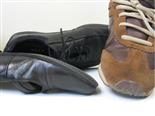
Textiles And Shoe Re-use:
Re-use of textiles and shoes helps people in need of clothing and means that fewer resources are used making new clothes.
Before sending any clothing or shoes to charity shops or other re-use centres, you should check that the clothing and shoes are in good condition and that they are relatively clean.
Why recycle textiles?
Benefits a good cause
Giving old clothes to charity for re-sale will benefit a very good cause.
Cuts waste disposal costs
Less waste has to be sent to landfill sites.
Recycled cotton
Cotton can even be recycled to make certain grades of paper.
Why recycle shoes?
The shoes you no longer use could benefit others if you donate them to charity shops or reuse schemes.
Once collected the shoes are sorted for suitability, and distributed to developing countries around the world.
The shoes are sold at affordable prices to local traders and craftsmen. All refurbishment work is done by local people, thus creating much needed employment, as well as providing shoes for people’s feet.
Before you bin it:
Old textiles can be made into cleaning cloths for the home.
Old clothes can be donated to friends, charity shops, jumble sales or sold at a car boot sale.
If you are donating clothes to a charity shop, ensure that they are clean as it costs money for the shop to launder them.
Recycling textiles can help the environment and generate money for your favourite charity. 90% of textiles in a recycling bank can be used in some way.
40% can be worn again.
15% is made into ‘shoddy’ (reclaimed wool fibre).
15% is used for filling for mattresses.
20% is made into wiper cloths.
10% cannot be used.
What happens to textiles when they are recycled?
Stage 1:
Used clothes and textile by-products are sorted with great care as they are used for specific purposes.
Stage 2:
The textiles are sorted by hand into over 100 different categories and grades.
Stage 3:
Cotton rags are made into industrial wipers for cleaning purposes.
Stage 4:
Woollen and knitted cloth is pulled into ‘shoddy’ and made back into cloth for use in the textile industry.
Stage 5:
Garments in good condition can be re-sold at modest prices to other parts of the world.
Stage 6:
Textile recycling provides raw materials for upholstery fillings, roofing felt and new clothes
Fascinating Facts:
- There are approximately 5,500 textile banks in the UK
- Over 70% of the world’s population wear second hand clothes
- Old woollen jumpers can be re-made into blankets
- There are approximately 300 kgs of clothes in a standard textile bank
- Textile banks are emptied by hand to ensure that no damage is done to the materials
- Africa has the highest demand for second hand clothes
Where to Recycle:
Against Breast Cancer
Against Breast Cancer raise money for vital research through their many recycling schemes.
Along with bras, Against Breast Cancer also recycle mobile phones, printer cartridges and clothes, as well as running a tree planting scheme.
For information about their recycling schemes, click here.